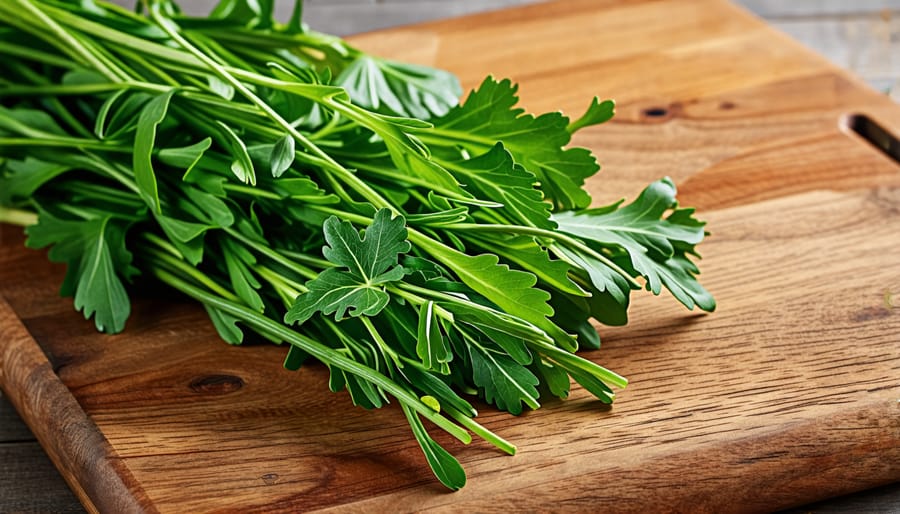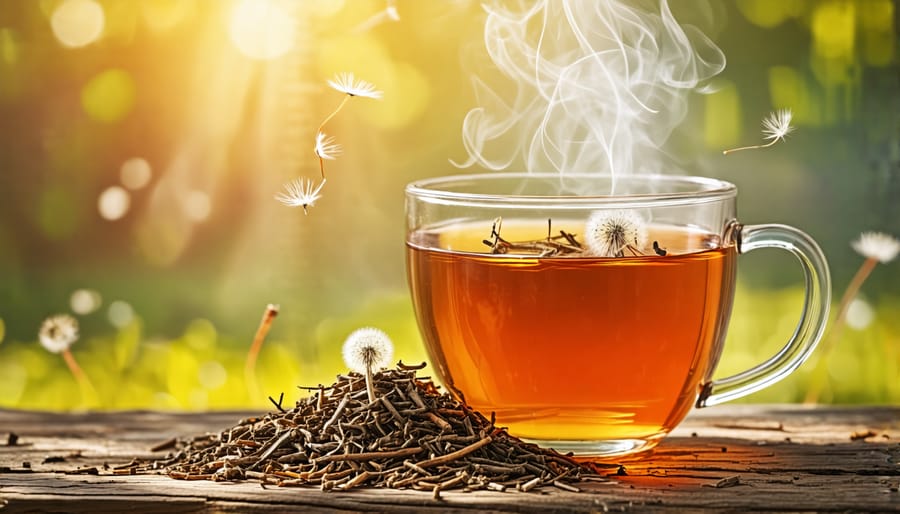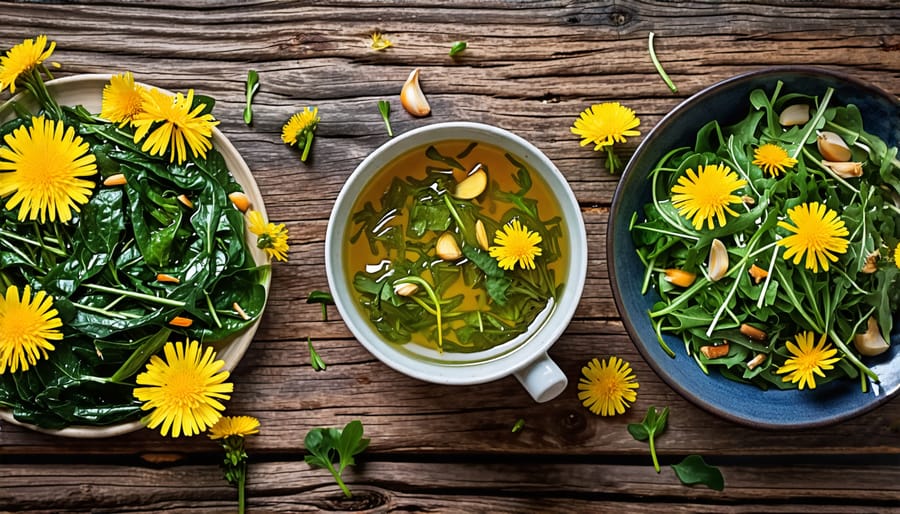Unlock the nutritious potential of the humble dandelion, a common weed with surprising versatility in the kitchen. Sauté young dandelion greens with garlic and olive oil for a vitamin-packed side dish. Roast the roots until crispy and grind them into a caffeine-free coffee substitute. Infuse dandelion flowers in honey or vinegar to add floral notes to salad dressings and marinades.
Dandelion Greens

Nutritional Benefits
Dandelion greens are a nutritional powerhouse, packed with essential vitamins and minerals. They are an excellent source of vitamin K, providing over 500% of the daily recommended value in a single cup. Vitamin K is crucial for blood clotting and bone health. Dandelion greens also offer substantial amounts of vitamin A, supporting eye health and immune function, and vitamin C, a potent antioxidant that aids in collagen production and tissue repair. Additionally, these greens contain significant levels of calcium, iron, and potassium, which contribute to strong bones, healthy blood, and proper muscle and nerve function. Dandelion greens are also rich in antioxidants like beta-carotene and lutein, which help combat oxidative stress and inflammation in the body. Incorporating this nutrient-dense green into your diet can provide numerous health benefits and support overall well-being.
Harvesting and Preparing
Dandelions are easily identifiable by their bright yellow flowers and distinctive, deeply-toothed leaves. When harvesting dandelion greens, look for young, tender leaves before the plant flowers. The best time to pick them is in early spring or late fall when the leaves are less bitter. Avoid picking dandelions from areas treated with pesticides or near roadsides.
To prepare dandelion greens, rinse them thoroughly under cold water to remove any dirt or debris. Remove the tough stems and discard any yellowed or damaged leaves. Dandelion greens can be enjoyed raw in salads, sautéed with garlic and olive oil, or added to soups and stews. Blanching the leaves in boiling water for a minute or two can help reduce their bitterness.
When cooking dandelion greens, pair them with flavors that complement their slightly bitter taste, such as lemon, garlic, or bacon. They can also be mixed with milder greens like spinach or lettuce to balance out the flavor. Dandelion greens are versatile and can be used in a variety of dishes, from omelets and quiches to pesto and smoothies.
Remember to always properly identify the plant and avoid consuming dandelions that may have been exposed to chemicals or pollutants. With a little preparation, these nutrient-packed greens can be a delicious and healthy addition to your meals.
Dandelion Roots

Dandelion Root Tea
Dandelion root tea is a natural beverage that has been used for centuries to support overall health and wellness. To make this tea, start by thoroughly washing and chopping fresh or dried dandelion roots. Roast the roots in the oven at 350°F (175°C) for about 30 minutes or until they turn dark brown and fragrant. This process helps to reduce bitterness and enhance the flavor. Steep 1 tablespoon of roasted roots in 1 cup of hot water for 10-15 minutes, then strain and enjoy.
Drinking dandelion root tea may offer several potential benefits. The roots contain antioxidants and anti-inflammatory compounds that can help protect cells from damage and reduce inflammation in the body. Some studies suggest that dandelion root may help support liver function, improve digestion, and promote healthy blood sugar levels. Additionally, the tea is naturally caffeine-free and can be a soothing, hydrating beverage to enjoy at any time of day.
While dandelion root tea is generally considered safe, it’s always best to consult with a healthcare professional before adding it to your wellness routine, especially if you have any pre-existing health conditions or are taking medications.
Roasted Dandelion Root
Roasted dandelion root is a natural, caffeine-free alternative to coffee that offers a unique, earthy flavor profile. To prepare, carefully harvest and clean the roots, chop them into small pieces, and roast in the oven until dark brown and fragrant. Grind the roasted roots and brew using your preferred coffee-making method, such as a French press or drip machine. The resulting beverage has a rich, slightly bitter taste reminiscent of coffee, but with the added benefits of dandelion root’s vitamins, minerals, and potential digestive support properties. Enjoy this natural, flavorful drink as a healthier substitute for your morning cup of joe.
Dandelion Flowers

Dandelion Wine
Making dandelion wine at home is a fun and rewarding process that allows you to enjoy the unique flavor of this wild flower. To begin, gather about a gallon of fresh dandelion flowers, ensuring they are free from pesticides and herbicides. Remove the green parts, as they can add bitterness to the wine. In a large pot, bring water to a boil and add sugar, stirring until dissolved. Remove from heat and add the dandelion petals, along with sliced oranges and lemons for added depth of flavor. Allow the mixture to steep for a few days, then strain out the solids and transfer the liquid to a fermentation vessel. Add wine yeast and let the mixture ferment for several weeks to a month. Once fermentation is complete, bottle the dandelion wine and allow it to age for at least a few months to develop its full flavor profile. The result is a delightful, slightly sweet wine with floral notes that can be enjoyed chilled on its own or paired with light appetizers and desserts. As with any home brewing project, be sure to follow proper sanitation practices and enjoy responsibly.
Edible Garnishes
Dandelion petals can add a pop of color and a touch of whimsy to various dishes. Sprinkle the bright yellow petals over salads for a visual and nutritional boost. They pair particularly well with bitter greens like arugula and endive, creating a balanced and eye-catching salad. For a delightful twist on baked goods, try incorporating dandelion petals into muffins, scones, or cookies. The petals’ subtle sweetness complements flavors like lemon, vanilla, and honey. You can also use dandelion petals to garnish soups, stews, and even cocktails. Not only do they add a charming aesthetic, but the petals also contribute antioxidants and vitamins to your dish. When using dandelion petals as a garnish, make sure to remove the green base of the petal, as it can be quite bitter. With a little creativity, these sunny petals can elevate the appearance and nutritional value of your meals.
Conclusion
In conclusion, dandelions are a nutritious and versatile freely available plant that can easily be incorporated into your diet. From the vitamin-rich greens to the prebiotic-packed roots and antioxidant-filled flowers, every part of the dandelion offers unique health benefits. By harvesting dandelions from your own backyard or local parks, you can enjoy this superfood without spending a dime. Whether you saute the greens, roast the roots, or infuse the flowers into tea, experimenting with dandelions in the kitchen is a fun and rewarding way to boost your nutrient intake. So the next time you spot a dandelion, don’t think of it as a pesky weed – instead, consider it a free and abundant source of nourishment right at your fingertips. Embrace the power of the dandelion and start incorporating this incredible plant into your meals today!

